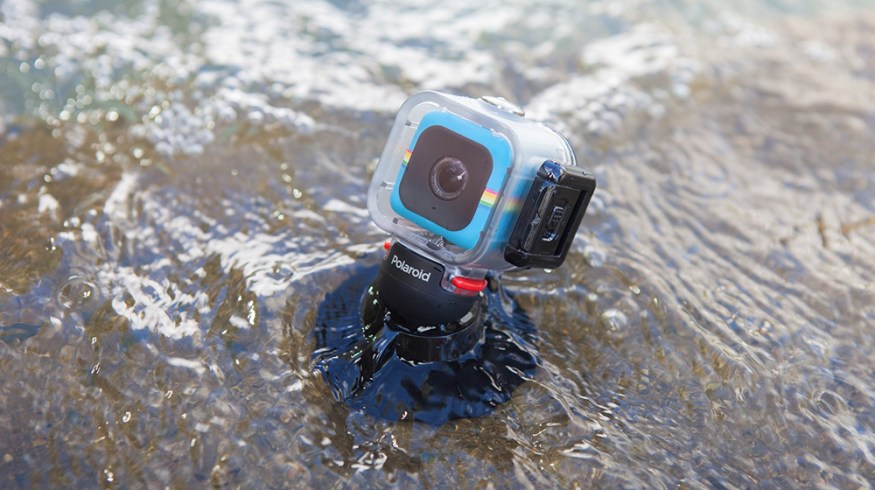
The Best GoPro Alternatives in 2016
The GoPro Hero has established itself as the preferred action camera for everyone from adrenaline junkies to budget filmmakers — but there are other options. Here are a few of the best GoPro alternatives.
Top image via Polaroid
GoPro rules the action camera marketplace, but there are plenty of reasonably priced alternatives to be found. Let’s take a look at some of the best GoPro alternatives available in 2016.
Xiaomi Yi

Image via Xiaoyi
Arguably the best bang for your buck on this list, the Xiaomi Yi is a Chinese GoPro lookalike with surprisingly impressive performance considering the price.
Unfortunately, it doesn’t include any accessories, and it is only compatible with Android phones. Featuring a f2.8, 155-degree lens and a plethora of video modes to choose from, this is still a better option than, say, the Polaroid Cube for those who want a little more control over their camera or shoot primarily first-person footage.
Price: $78 USD ($89 USD with housing)
Battery Life: 45 minutes to 2 hours of recording
Video Quality: 2.7K [30FPS], 1080P [60FPS], 720P [240FPS]
Maximum Card Size: 64GB
Image Stabilization: No
External Audio: No
WiFi: Yes
Megapixels: 16MP [7FPS burst]
PROS:
- Lots of recording modes
- Price
- Simple design
- Wide angle is great for first-person view
CONS:
- Only supports Android phones
- Chinese instructions and support
- No accessories included
- Poor battery life
- Fish-eye distortion
Polaroid Cube HD

Image via Polaroid
Geared more towards casual, on-the-fly videography, the Polaroid Cube is one of the simplest action cameras on the market. It covers the basics, like photography and 1080P video, but doesn’t offer much beyond that.
Not factory-waterproof, nor built to sustain heavy impacts, the Cube is best for capturing risk-free moments. With a 124-degree lens (significantly narrower than the Xiaomi) it provides a flatter, more honest image than other similar cameras. Possibly the coolest feature of the Cube is the magnetic base. If you’re looking for a pocket-sized device that you can instantly shoot with at any moment, the Polaroid Cube is likely what you need.
Price: $80-$100 USD
Battery Life: 1.5 hours of recording
Video Quality: 1080P [30FPS]
Maximum Card Size: 32GB
Image Stabilization: No
External Audio: No
WiFi: No
Megapixels: 6MP
PROS:
- Magnetic mount
- Can record indefinitely when charging
- Easy to use
CONS:
- Records .MOV format
- No burst photos
- Video clips are broken into 5-minute segments
- 1080P compresses audio more than 720P
Polaroid Cube+

Image via Polaroid
A slightly beefed-up version of the successful Cube, the Cube+ brings higher resolution, higher frame rates, higher SD card capacity, and additional features like WiFi and image stabilization.
Whether or not these extra features are worth the higher price is up to you, though compared to similarly priced competitors, it’s certainly lacking in included accessories. Regardless, the Cube+ is a very capable rugged action camera with a simple design and interface. It will get the job done.
Price: $148 USD
Battery Life: 107 minutes of recording
Video Quality: 1440P [30FPS], 1080P [60FPS], 720P [120FPS]
Maximum Card Size: 128GB
Image Stabilization: Yes [Digital]
External Audio: No
WiFi: Yes
Megapixels: 8MP
PROS:
- Compact design
- Easy to use
- Shockproof even without housing
- High SD card capacity
- Magnetic mount
- Can record indefinitely while charging
CONS:
- Prevalent audio issues in current model
- Few accessories for the price
- Still not factory waterproof
Sony AZ1

Image via Sony
The Sony AZ1 is designed mainly for the first-person perspective. With a field-of-view of up to 170 degrees, and crisp, high-bitrate video, the AZ1 holds its own against similar cameras like the mid-range GoPros. It even includes GPS functionality, a rare feature in this price range. While its battery life has its limits, it remains impressive how much technology Sony managed to cram into this little device.
Price: $148 USD
Battery Life: 1.5 hours
Video Quality: 1080P [60FPS], 720P [120FPS]
Maximum Card Size: 128GB
Image Stabilization: Yes [Digital]
External Audio: No
WiFi: Yes
Megapixels: 11.9MP [8FPS burst]
PROS:
- Compact design
- Multiple field-of-view mode
- High-bitrate XAVC S Codec
- Includes adequate accessories
- Multiple color modes
CONS:
- No wireless file transfer
- Narrow-angle modes automatically use stabilization
- Suffers in low light
- Fisheye distortion
Garmin Virb XE

Image via Garmin
Garmin, a leading name in the GPS Navigation industry, presents its answer to the GoPro Hero. The most similar to the Hero 4 in appearance and structure, the Garmin Virb XE is an especially appealing option to Garmin fans and lovers of the outdoors.
While some customers have occasionally reported software bugs and battery decay, the Virb is generally a very durable camera, built to take anything you throw at it. With underwater resistance of up to 50 meters (far deeper than any of its competitors), a quick-record on/off toggle switch, GPS data logging, and support for wireless audio input, the Virb XE is an extremely versatile action camera. You can even control it wirelessly with other Garmin devices!
Price: $333 USD
Battery Life: 2 hours of recording
Video Quality: 1440p [30FPS] 1080P [60FPS]
Maximum Card Size: 128GB
Image Stabilization: Yes [Mechanical]
External Audio: Yes
WiFi: Yes
Megapixels: 12MP [30FPS burst]
PROS:
- Accessory bundle options
- GPS Data
- Waterproof up to 50 meters
- Manual exposure and white balance
- Quick-Record toggle switch
- Compatible with most GoPro mounts
- Wireless audio input
- Weather-proof cable
CONS:
- Battery life
- Potential software bugs
- Proprietary cable
- No 4K
- No tripod mount
- Awkward shape
TomTom Bandit

Image via TomTom
An often overlooked option, the TomTom Bandit excels primarily in its convenience. With a 3-hour battery life, compact build, and built-in media server, it is designed to make your video sessions as productive as possible. Like the Garmin Virb XE, the Bandit records extensive data in tandem with video, such as speed, G-force, altitude, and even heartbeat! It has a cylindrical, but rather unique design with a built-in USB stick. The TomTom also features the ability to mark highlight points with a single button press while recording, so as to later locate your best moments instantly.
Unfortunately, the TomTom struggles in low-light conditions, and only records 4K at 15 frames per second, making the 4K mode largely useless. With that being said, it’s worth noting that they at least pushed the hardware as far as they could and included 4K at all, even if the framerate voids its general use. It does still record 2.7K at 30 frames per second, which is still a step above the resolution abilities of the Garmin Virb. Despite its slight shortcomings in video quality, this little action camera has a lot to offer in convenience and data.
Price: $396 USD
Battery Life: 3 hours of recording
Video Quality: 4K [15FPS], 2.7K [30FPS],1080P [60FPS]
Maximum Card Size: 128GB
Image Stabilization: No
External Audio: Yes
WiFi: Yes
Megapixels: 16MP [10FPS burst]
PROS:
- GPS Data/Heartbeat Band
- Cordless USB
- On-the-fly highlight markers
- High resolution photos
CONS:
- No PC/OS X software
- 4K’s low framerate makes it mostly useless
- Poor low-light performance
Sony FDR-X1000V/W

Image via Sony
By far the most popular alternative to the GoPro, Sony’s camera is built like many action cameras were prior to the success of GoPro. The cylindrical shape makes it a bit more flexible in many mounting situations (especially on helmets), and with the help of a Zeiss lens and Sony’s fantastic sensor technology, it produces stunning, wide-angle video quality that in many ways even trumps that of the GoPro Hero 4 Black. Despite occasional complaints regarding the clunky software and the camera’s limitations in 4K (e.g. no image stabilization and halved battery life), the camera has received overall positive feedback.
It includes GPS functionality, but only records basic data like speed and timing. Though it isn’t built quite as tough as its competitors, it compensates for it with high-fidelity images, multiple accessory bundle options, and its notable WiFi capabilities (multi-camera control and live streaming). If you’re more concerned about how your footage looks than the conditions under which it is shot, this is probably the best choice for you.
Price: $398 USD
Battery Life: 50 minutes to 2 hours of recording
Video Quality: 4K [30FPS], 1080P [120FPS], 720P [240FPS]
Maximum Card Size: 64GB
Image Stabilization: Yes [Digital]
External Audio: Yes
WiFi: Yes
Megapixels: 12.8MP [10FPS burst]
PROS:
- Accessory bundle options
- Excellent video quality
- Zeiss Lens
- Built-in tripod mount
- Multi-camera simultaneous WiFi support
- Many recording modes
- Wide Field of View
- Livestream capabilities
- In-Camera editing
- Versatile Shape
CONS:
- Only waterproof up to 3 meters
- Fisheye distortion
- Less durable than competitors
- Clunky software
- Low photo resolution
- Does not support cards over 64GB
Regardless of what you plan to shoot, at least one of these action cameras should meet your budget and technical needs.
Do you think the GoPro will continue to dominate this increasingly saturated market? Let us know in the comments below.





